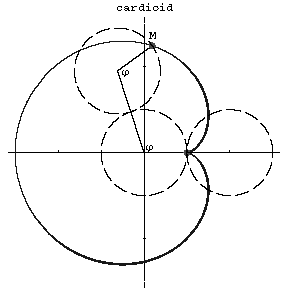Difference between revisions of "Cardioid"
From Encyclopedia of Mathematics
(Importing text file) |
(TeX) |
||
| Line 1: | Line 1: | ||
| − | A plane algebraic curve of order four which is described by a point | + | {{TEX|done}} |
| + | A plane algebraic curve of order four which is described by a point $M$ of a circle of radius $r$ rolling on a circle with the same radius $r$; an [[Epicycloid|epicycloid]] with modulus $m=1$. The equation of the cardioid in polar coordinates is: | ||
| − | + | $$\rho=2r(1-\cos\phi),$$ | |
In Cartesian coordinates it is: | In Cartesian coordinates it is: | ||
| − | + | $$(x^2+y^2+2rx)^2=4r^2(x^2+y^2).$$ | |
The arc length from the cusp is: | The arc length from the cusp is: | ||
| − | + | $$l=16r\sin^2\frac\phi4.$$ | |
The radius of curvature is: | The radius of curvature is: | ||
| − | + | $$r_k=\frac{8r}{3}\sin\frac\phi2.$$ | |
| − | The area bounded by the curve equals | + | The area bounded by the curve equals $S=6\pi r^2$. The length of the curve is $16r$. The cardioid is a [[Conchoid|conchoid]] of the circle, a special case of a [[Pascal limaçon|Pascal limaçon]] and a [[Sinusoidal spiral|sinusoidal spiral]]. |
<img style="border:1px solid;" src="https://www.encyclopediaofmath.org/legacyimages/common_img/c020390a.gif" /> | <img style="border:1px solid;" src="https://www.encyclopediaofmath.org/legacyimages/common_img/c020390a.gif" /> | ||
Revision as of 21:00, 11 April 2014
A plane algebraic curve of order four which is described by a point $M$ of a circle of radius $r$ rolling on a circle with the same radius $r$; an epicycloid with modulus $m=1$. The equation of the cardioid in polar coordinates is:
$$\rho=2r(1-\cos\phi),$$
In Cartesian coordinates it is:
$$(x^2+y^2+2rx)^2=4r^2(x^2+y^2).$$
The arc length from the cusp is:
$$l=16r\sin^2\frac\phi4.$$
The radius of curvature is:
$$r_k=\frac{8r}{3}\sin\frac\phi2.$$
The area bounded by the curve equals $S=6\pi r^2$. The length of the curve is $16r$. The cardioid is a conchoid of the circle, a special case of a Pascal limaçon and a sinusoidal spiral.

Figure: c020390a
References
| [1] | A.A. Savelov, "Planar curves" , Moscow (1960) (In Russian) |
Comments
References
| [a1] | J.D. Lawrence, "A catalog of special plane curves" , Dover, reprint (1972) |
How to Cite This Entry:
Cardioid. Encyclopedia of Mathematics. URL: http://encyclopediaofmath.org/index.php?title=Cardioid&oldid=13869
Cardioid. Encyclopedia of Mathematics. URL: http://encyclopediaofmath.org/index.php?title=Cardioid&oldid=13869
This article was adapted from an original article by D.D. Sokolov (originator), which appeared in Encyclopedia of Mathematics - ISBN 1402006098. See original article